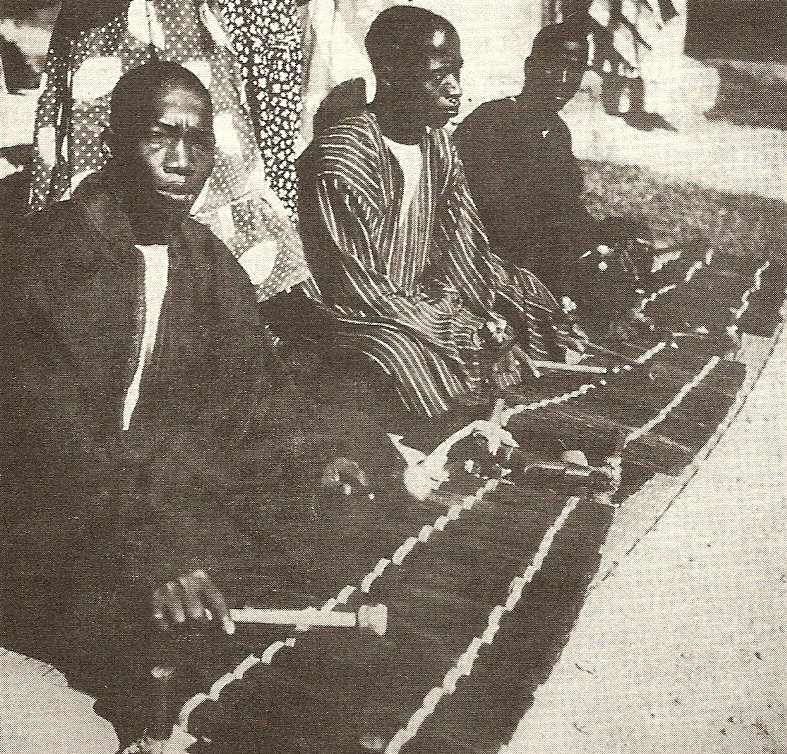Sidi Mamadi Dioubate
Biographical Information
Born: Guinea; Kankan
Son of: Dioubate, Sidi Djeli
References
Charry, Eric. 2000. Mande Music: Traditional and Modern Music of the Maninka and Mandinka of Western Africa. Chicago; London: University of Chicago Press.
p. 248
[Faceli Kante's] granduncle Diaraba Kante was the lead bala player with the National Instrumental Ensemble of Guinea, and an aunt was Nyamakoron Kante, one of Guinea's great jelimuso singers, who married Sidi Mamadi Dioubate (Diabate), one of Guinea's most respected bala players of the 1940s and 1950s and cofounder with his brothers of the musical movement known as Mamaya. Nyamokoron and Sidi Mamadi's daughter Oumou Dioubate is at present one of the most important singers in Guinea.
p. 286-8
Mamaya, a social event that arose among youth in Kankan sometime in the 1930s, deserves special notice (Kaba and Charry, forthcoming). Although the actual event, which includes slow group dancing in a circ1e, fell out of favor by the 1960s, it continues to provide musical inspiration for Guinean musicians. The music of Mamaya comes from the bala, and it originated among the bala-playing family of Sidi Dioubate and the virtuoso bala ensemble of his sons Sidi Mamadi, Sidi Karamon, and Sidi Moussa (plate 48).

Plate 48 Dioubate Brothers of Kankan, 1952. From Rouget and Schwarz (1969, facing 48).
The reverence in which these musicians were, and still are, held and the continued interest in this piece make Mamaya an extraordinary phenomenon in the history of Mande music.
Alberts (1949-disc, 1998-disc) made recordings in Kankan in 1949, and the bala players and singers, identified by Alberts as being recorded at Sidi Djelli (the name of the family patriarch), are certainly the Kankan Dioubate family performing Mamaya. Rouget (1954a-disc, 1954b-disc) recorded the Dioubate brothers in Kankan in 1952 and published an article on bala tuning based on measurements he made of their three balas (Rouget and Schwarz 1969).45 Recent recordings associated with Mamaya are revealing of change and renewal in Maninka music. Oumou Dioubate (1992?-disc), daughter of Mamaya cocreator Sidi Mamadi Dioubate, pays homage to her grandfather Sidi Dioubate in Sididou (Sidi's place) by systematically naming the children and grandchildren, thereby praising Sidi for his progeny. An extended sung genealogy like this in a modern music setting is uncommon (especially when one's own family is concerned), but Sidi Dioubate's heroic status as Mamaya creator merits this special treatment. Oumou's older sister Nakande Diabate (daughter of Sidi Mamadi and Namama) has recently recorded a version of Mamaya with jembe player Mamady Keita (1995-disc), with lyrics all but identical to the version recorded by Alberts forty-five years earlier.
45. Although Boulton's film is cataloged as being shot in Bamako and Bankumana, Mali, several African viewers believe that parts of it may have been shot in Guinea. The Kankan musicians playing on the Alberts (1949-disc) recordings were easily identified during my 1994 trip to Conakry. Ntenen Janka Saran, younger sister of the bala-playing Dioubate brothers and aunt of my host Kabine Kante, made the most moving identification, recalling that she was one of the young girls singing on the tape (see Alberts 1998-disc for a photo of the female chorus; Rouget 1999-disc has a photo of the bala players and their wives). Hearing old recordings is not a common experience for many Africans, and she broke down in tears on hearing her long departed family members, just as her nephew had predicted.
Discography
· kairad; kalad; mamadou bitikid; mamayad; nanfulend
[No Pieces Indexed]
[No Pieces Indexed]
· kairad
· kairad
Videography
· nanfulenv